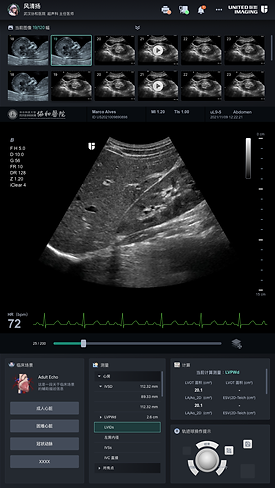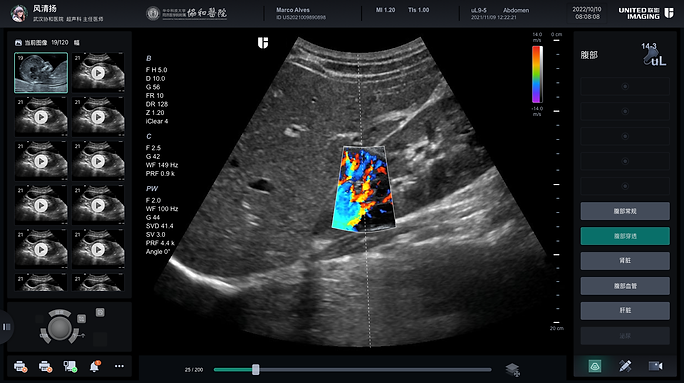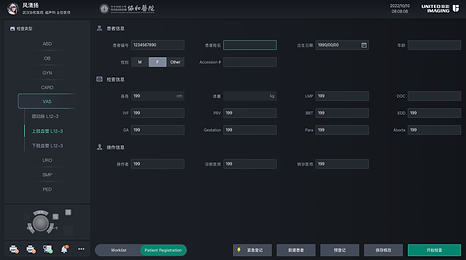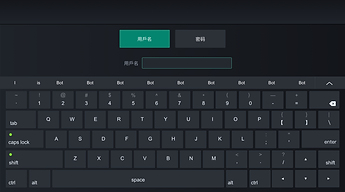
US1 First-Gen Ultrasound

Developing Cities In China Are In Desperate Need of High-efficiency and Cost-effective Medical Equipment
Product Strategy
China (Mainland)
Market
19.8 B
The Chinese ultrasound equipment market is expected to exceed $19.8 billion by 2029.
CAGR 6.25% (2020-2029)
Global CAGR 4.8% (2020-2029)
Tier 2
Hospitals
46.5 %
40.6 %
Tier 3
Hospitals
The sales of second and third-tier hospitals account for over 86% (46.5% and 40.6% respectively)
Medium-high-end Cart is the most popular
Mainstream: General Imaging
product positioning
Client
2nd and 3rd tier hospitals
Application
General Imaging
Performance
Medium-high end
Design Process
Research
Month
Reviewed and organized interview data
Hardware sourcing
Established design principles
Co-create UI workflow with product team
User interface design
Usability testing
Qualitative Research
02
03
04
05
06
07
08
09
2021
10
11
12
01
02
03
2022
PRD/Design iteration
Front-end develop
Greenlight granted by CEO
agile development
prototyping
04
05
06
07
08
role
Product Owner
Product Designer
User Researcher
UX Designer
Front-end Team
Business Analyst
responsibilities
-
Competitor Analysis: Research user workflow and user interface from 4 industry-leading competitors.
-
User research: Lead user research activities with the product team. Assist C-levels in making strategic decisions for US1.
-
Product Design: Work with clinicians and product owners to create solutions. Design high-fidelity prototypes and work with developers to create MVPs.
-
Agile usability test: Apply the methodology and make product usability testing ‘Agile’. Pilot with internal and external stakeholders within a tight schedule.
-
Establish interaction design principles and guidelines from zero to one.
Research:
Identify Requirements From Key Opinion Leaders
User Needs And Painpoints
At the event of stepping in as the design lead of the project, I was told that there were several interviews done months ago with some of the notable hospital doctors whom we collaborate with. What a great way to start the onboarding process! The whole workflow process can be summarized into 8 steps. I immediately identified user needs and pain points from the interview record.
user journey
User Login
Reasonable patient visit process settings, creating a good patient experience
Measure
Reducing the workload of doctors in searching for lesions during image recognition
Volume measurement requires faster speed and higher accuracy
Automatically display simple calculation values through doctor's dictation
Needs
Painpoints
Patient Check-in
When using a keyboard, it is very inconvenient and inefficient
Scan
When pressing keys around the trackball, it is important to avoid accidental presses on frequently used keys
The operation of adjustment buttons should be as effortless and time-saving as possible
Assist and guide novice doctors in performing probe movements
Due to physical limitations, doctors are unwilling to perform scans independently and instead rely on technicians to handle the task
It is necessary to prevent misdiagnosis as it can easily occur
The user experience of using the freeze button should be very good, and it should be very easy to use
Review
The importance of providing clear and high-quality images is fundamental. Displaying images in the largest and clearest format possible, allowing doctors to easily identify any abnormalities and make confident treatment decisions
Annotation
/
Report
Report layout is easily achieved based on the desired number of images to be displayed, while ensuring image clarity
End Exam
/
Anchoring "User Experience Metric" As The Primary Competitive Advantage
User Value =
New Experience
*Perceived benefits of a product greatly influence the willingness of users to pay for it
Standard components
Process guidance
Innovative approaches to operate
-
Old Experience
User habits
Comprehensive functionality
-
Cost of Switching
Adaptation and learning costs
Development and waiting costs
competitors


GE, Philips, Siemens, and Mindray are direct competitors in top-tier models of general imaging.
Design Principles
1. Workflow Simplicity
Context-based clinical exercise
traditional probe-based operation
Activate Equiment
Patient Check-in
Select Probe
Scan
-
Measure
-
Annotation
Report
End Exam
context-based operation
Activate Equiment
User Login
Select Clinical Context / Scenario
Allowing users to customize their settings based on their individual habits and preferences.
-
Patient check-in
-
Select the desired position for the procedure, rather than having to choose from a list of probes
-
Measure / Annotation / Report function is intelligently designed to adapt to the specific clinical scenario chosen by the operator
End Exam
"Reduce operation time and cost by 40%"
2. Human-equipment Ergonomics
Positioning The Operation Center Slightly To The Right
Observation
-
Our findings revealed that due to the positioning of the patients on the right side of the operator, the operator tends to lean right, leading to physical strain over prolonged usage periods.
-
Additionally, we received feedback from experienced operators who have used the equipment for decades, expressing their dissatisfaction with the lack of ergonomic design, resulting in physical pain.
Approach
With these factors in mind, we took the initiative to shift the user interface and physical keyboard slightly to the right, resulting in a 30% reduction in physical burden, without causing any perceptible change to the operators' experience.
Machine Center
Operation Center


3. Adaptability
Integrate Landscape + Portrait Setting
portrait
mode
landscape
mode




Primary Setting: Landscape
This is the most commonly used setting by doctors when operating the equipment, with approximately 90% of operators accustomed to this configuration due to their established habits.
Additionally, 80% of the market utilizes this fixed product setting, making it a widely accepted and proven choice.
Touch Screen
Our ultrasound machines feature a touch screen interface designed to provide an intuitive and familiar experience for operators, enhancing productivity and reducing the need for extensive training.
The decision to incorporate touch screens was based on the goal of creating a user-friendly and efficient tool for operators of all skill levels.
Secondary Setting: Portrait
We found that doctors who operate in specific contexts such as the 4-view and PW mode require a larger viewing area for optimal clinical performance. Extensive testing has shown that this feature significantly enhances the user experience.
In order to distinguish ourselves from our competitors, we have integrated both landscape and portrait settings to create a comprehensive clinical application that fits within budget constraints.
This innovative solution allows for a larger viewing area that enhances performance, and is a clear advantage over our competitors.
Workflow/
UI


fonts & colors

Primary - Main
096F69
Extension - Sub
04856F
Primary - Secondary
434B59
Extension - Title
D8D8D8
Primary - Background
Gradient: 13151A - 1E2229
Extension - Button
2C3138
Primary - Font
FFFFFF9
Error - Text Field
E36732
End Exam
B95353
Microsoft YaHei
Regular
Semi bold











Enabled Product Owner Alignment Through Co-creation
Facilitated co-creation sessions to promote alignment among multiple product owners for the entire product.
 |  |  |
|---|---|---|
 |  |  |
product visualization canvas

Agile Approach: Fast-paced Iteration of Software And Hardware Through Testing
usability
Testing
prD/Design
iteration
other
Phase
front-end
develop
Week
01
02
03
04
1.0 Paper Testing
05
Retrospect
Execution plan for x.0
Recruiting testee
2.0 Demo Testing
06
07
08
09
10
3.0 Hardware Testing
11
12
13
14
15
4.0 Expert Testing
16
17
18
19
20
5.0
1.0 Paper Testing
2.0 Demo Testing
3.0 Hardware Testing
4.0 Expert Testing
Background
Users provide ideas and iteration basis for the first generation product based on their own experiences and familiarity with existing ultrasound products in the industry.
Users have a basic understanding of the product form, but lack in-depth knowledge about the interaction details.
Users demonstrate interest and enthusiasm in testing activities by personally simulating the operation of product prototypes.
Users have a basic understanding of the product workflow and design but desire professional guidance to provide more inputs to shape the final product form.
Goal
Understand:
-
The acceptance of portrait mode and layout among users.
-
Users' ideas about clinical scenario concepts.
-
Users' opinions about My Workspace.
-
Users' thoughts on using a personal account to log in to the machine.
-
Users' opinions on the control panel solution.
-
Conduct user research on the horizontal screen interface workflow.
-
Gather feedback from users on their experiences and thoughts regarding the clinical scenario solutions.
-
Obtain user input on the functionality, placement, and size of control panel buttons.
Understand:
-
Users' opinions and preferences between vertical and horizontal screen orientation options.
-
Users' feelings and thoughts regarding the current human-machine interface structure.
Understand:
-
Clinical usage requirements of different ultrasound experts in various fields, such as desktop ultrasound, bedside ultrasound, wireless probes, remote ultrasound, AI, etc.
-
Optimization points of the control panel based on user feedback.
-
Users' future expectations for touch screen sizes.
-
Optimization points for the main interface layout based on user feedback.
-
User acceptance and optimization points for clinical scenarios.
-
Optimization points for scanning parameters based on user feedback.
-
Optimization points for "My Workstation" based on user feedback.
-
User perceptions of overall controls and interface design elements.
Record




Tester
Potential users who are Expert-level doctors, Director-level doctors, General-level doctors, Final users who have a decisive influence on the product and future ultrasound products.
Testee
User Experience Designers, Product Managers, Clinical Experts, Software Developers
5.0 Clinical Trial (In Progress)
-
Conduct a survey to determine if all implemented software functions comply with regulatory standards.
-
Investigate if the overall design of the device meets human-machine interface regulatory standards.
-
Survey users to determine if US1 meets clinical benchmarks and identify areas for improvement.
-
Evaluate the patient experience (if real patients are involved) during diagnosis and treatment.
